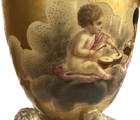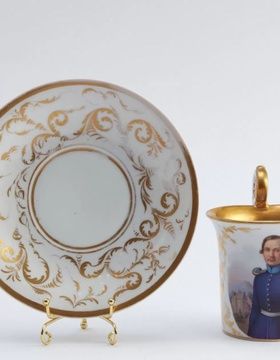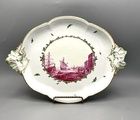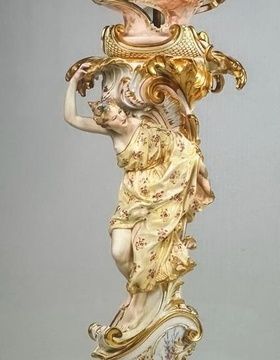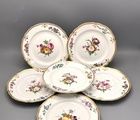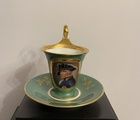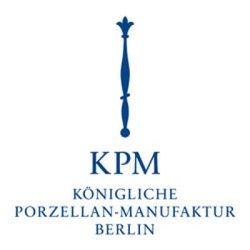
Королевская фарфоровая мануфактура (КРМ).
Переход фабрики в другую собственность -1763 г.
После перехода фабрики Гоцковского к Фридриху II она стала называться Королевской фарфоровой мануфактурой, и ее клеймом с самого начала был королевский скипетр. Одновременно стали искать собственные залежи каолиновой глины. И уже в 1765 г. такие залежи нашли в Силезии, а в 1771 г. обнаружили прекрасную каолиновую глину в Бахвице около Галле и в Зенневице и Морле, и эти залежи Берлинская мануфактура использует по сей день. Фарфор из этой глины имеет синевато-белый оттенок. В то время фабрика выполняла многочисленные заказы короля, среди которых преобладали заказы на сервизы. В 1765 г. Фридрих II заказал сервиз, состоящий из большого количества разнородных предметов для нового дворца в Потсдаме. На изготовление этого сервиза ушло более двух с половиной лет. Этот сервиз стал шедевром фабрики, он превосходно подходил к стилю всего дворца, и на каждом из предметов была очаровательная и гармоничная роспись. Особенно одинаковый стиль росписи был на тарелках. Изящные мотивы из ракушек (rocaille) переходят от краев к середине, которую занимает букет цветов. Поля краев тарелок, между узорами из ракушек, покрывает тонкая золотая сетка на оранжево-красном фоне, на других полях на желтом фоне помещены золотые веточки. Преобладают тона: пурпурно-фиолетовый, желто-зеленый и коричнево-красный, а также тонкая позолота. Кроме описанного «потсдамского» сервиза фабрика выполнила еще много других для разных королевских резиденций, такие как «зеленый», «желтый», «красный», «японский», «с корзиной цветов». Для подарка короля русской императрице фабрика сделала в 1772 г. сервиз золотисто-зеленого цвета с миниатюрами, изображающими победу русских над турками.
В этот период для фабрики делал проекты декорирования также польский художник Даниэль Ходовецкий. Помимо королевских заказов фабрика выпускала массовую продукцию, не так богато украшенную, зато более дешевую и доступную обывателю. Кроме столовых сервизов выпускались кофейные сервизы, декоративные вазы и глазурованные статуэтки. Однако вазы и статуэтки не обладали той оригинальностью форм и легкостью, какие были у изделий некоторых других мануфактур того времени - мейсенской, венской или севрской. В 1775 г. в течение короткого времени скульптурной мастерской руководил Иоганн Эпштейн. Он сделал ряд фигурок и групп фигурок, в том числе на польскую тематику. Они изображали шляхтичей в польских костюмах и всадников с лошадьми.
После смерти короля Фридриха II в стиле изделий стал преобладать классицизм. Когда умер Элиас Мейер (1789), его место занял скульптор Карл Фридрих Ризе. Изделия этого периода - бисквиты в классическом стиле, сделанные в основном по проектам знаменитого скульптора Шадо- ва. Вместе с Шадова работал архитектор Ганс Христиан Дженелли, сторонник строгого классицизма. В этот период было сильно влияние Севра и керамики Веджвуда.
Портреты в медальонах, украшавшие берлинскую ампирную посуду и чашки, являются по большей части произведениями скульптора Леонарда Поша. Реакцией на холодный классицизм был стиль бидермейер, отвечающий мещанской любви к удобству и уюту. Изделия Берлинской фабрики именно в таком стиле имели широкой сбыт. Это были массовые изделия, но с определенным специфичным очарованием этой эпохи. Следует особенно выделить бидермейеровскую посуду, сделанную по проектам Карла Фридриха Шинкля. В середине XIX в. произошло снижение художественного уровня изделий, которые все больше походили на массовую фабричную продуцию. После периода застоя художественным руководителем в 1886 г. стал художник Александр Кипе. В течение двадцати лет его работы фабрика обрела свое прежнее положение. На рубеже XIX-XX вв., когда во главе мастерской росписи стал Шмуц- Баудис, здесь широко применялась техника подглазкрной росписи подглазурные, с помощью которой были созданы интересные и эффектные предметы. Он пригласил в Берлин скульптора Пауля Шойриха, который в своих работах часто обращался к доброй традиции рококо. Нынешнее производство Берлинской фабрики нацелено на выпуск декоративой посуды и ваз, причем главный упор делается на простоту и гармоничность формы. Во время последней войны фабрику на некоторое время перевели в Зельб, где с XVIII в. находился ее филиал. В 1955 г. мануфактура вернулась на свое прежнее место в Берлине (на территории ГДР), и она теперь носит название «Государственная фарфоровая мануфактура в Берлине».
В начальный период изделия Королевской мануфактуры в Берлине маркировались буквами «КРМ» (Konigliche Porzelcan Manufaktur) со скипетром или прусским орлом над буквами - период правления короля. Позднее в качестве клейма ставили схематический рисунок скипетра, рядом с которым часто стоят знаки художников или дополнительные знаки.

Аукцион искусства и старины art-picture.ru предоставляет возможность покупки
приобрести представленны лоты по теме "KPM /КПМ/"


